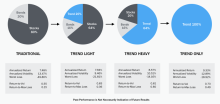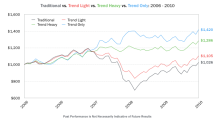
Trend Following
Trend Following may be the best way to invest your money that you've probably never heard of.
Would you like to increase your returns, decrease your risk, and help protect your capital in uncertain times?
This post will show how Following the Trend, instead of the herd, Can potentially be a better way to invest your money, especially in uncertain times.
Markets can be a dangerous sandbox to play in. Markets and stocks don’t always go up. Sometimes, they go down by a lot and stay down for a long time. Do you have a plan to get out and protect your money? New opportunities come along and produce massive trends. Do you have a plan to take advantage? How do you capture trends while also managing risk?
Trend Following addresses these questions head-on and provides a strategy for making money in all market environments.
What is Trend Following?
Respect the trend. Go with the flow. Diversify. Manage Risk. Follow the rules.
Trend Following is a trading strategy that requires only one input. That input is price. The price of any investment reflects all available information about it and how investors interpret that information.
Trend Following is a straightforward method of investing that has similarities to surfing. For those of you who don't know me, I love to surf. I am not very good at it but appreciate it as an art form and sport that is largely overlooked, much like trend following. I will explain trend following using the surfing analogy, but let's clarify what Trend Following IS NOT before we begin.
Trend following does not:
- Conduct fundamental research & analysis
- Employ large teams of analysts
- Use earnings reports, P/E ratios, ratings, etc. to determine when to buy & sell
- Care about "expert" opinions or how other fund managers are positioned
So how is Trend Following like surfing? Trend Following addresses all the variables, both technical and human, that must be addressed for a robust and successful investment plan.
For those of you that haven't tried surfing I will provide some context.
What surfboard to use (what system do you use to invest?): Do you want to surf fast or slow? Your experience and personal preferences determine what type of surfboard (investing system) you use.
Which beach to surf (which markets to invest in?): There are as many beaches to surf as there are markets and stocks to invest in. Choosing which one to surf (invest in) depends on your style and surfboard (investing system).
What size wave do you try to ride (how much risk to take in each investment?): The size of wave (investment allocation) you choose to ride (buy or sell) depends upon your experience, style, surf conditions, and surfboard (investing system).
How do you catch a wave and how long do you ride it (when do you buy an investment and how long do you hold on to it?): Overthinking and/or waiting for the perfect wave (investment opportunity) is futile. You can catch a wave (investment) early, spot on, or late. You can also get off the wave (sell your investment) early, spot on, or late. You won't know if you have caught the wave early, spot on, or late until you are already on it. The key is to be able to continue to surf until you get the big wave. Riding the big wave makes up for all your failed attempts and then some!
Why should you use a Trend Following Strategy?
Why is it a stronger, if not better, alternative to traditional fundamental buy and hold index investing?
Higher absolute and risk-adjusted returns over the long run.
Trend Following performs equally, if not better than the traditional investing most of us are used to. This is achieved because it eliminates irrelevant variables that are not necessary and incorporates variables that lead to more opportunities.
Let me clarify:
Trend Following does what traditional investing does not:
Diverse market selection: Trend Following observes all liquid markets and asset classes. Traditional investing isolates itself into a couple of different markets and misses out on opportunities in other areas.
Long, short, or flat: Traditional investing focuses on the buy & hold principle (long only) meaning you can miss out on a lot of downtrend opportunities and you stay invested when no opportunities exist. Trend Following adapts to each market's trend, so it can take advantage of up and down trends.
Robust risk controls: The traditional investing philosophy is to buy, hold, and hope for down-trending markets to come back. Trend Following does not enter any investment without first determining the maximum risk allowed for that trade and when to get out.
Humans are not rational investors: Traditional investing philosophy is largely based on the Efficient Market Hypothesis, which assumes humans always make rational decisions. This notion is flat-out wrong. Humans constantly let emotions drive their investing decisions. Trend Following, through a rules-based approach, eliminates emotional decision-making.
Why Don't more people know about Trend Following?
The lack of awareness for Trend Following comes down to one thing, marketing. This lack of awareness is two-fold. First, most investors have never heard of it. Secondly, most so-called "financial advisors" never learned about it during their training thus they are not familiar with it.
The Trend Following community does not make it a priority to market their alternate style of investing simply because they are not marketers, they are traders.
However, over the last decade, the combination of increased access to information, the Financial Crisis wreaking havoc on traditional portfolios (and investors naturally asking questions about how to prevent this), and Trend Following performing very well during this period, created more awareness.
Wall Street firms, with unlimited marketing budgets, bombard investors every day with the message, "Buying and Holding fee index funds is the only way to invest." This is understandable. Wall Street has built up the infrastructure in such an inflexible way that they cannot possibly think differently. It's become too expensive to change their minds. So, they continue pushing the same old message and do whatever they can to keep people investing the way they always have
How does Trend Following fit into your traditional investments and financial plan?
Part of building a financial plan is to assess where you are and where you want to go, and then build a roadmap of how to get there. In addition to this, the financial plan addresses potential pitfalls as well as solutions on how to plan for them. In other words, a financial plan helps you prepare for the best, but plan for the worst.
Trend Following does the same thing! People who understand the value of a financial plan will understand and appreciate the value of Trend Following and how it all fits together. Trend Following takes care, in part, of the investing strategy of your financial plan.
Quite simply, Trend Following can help you grow your capital more efficiently than buy-and-hold index investing. i.e. achieve similar or higher returns while incurring less volatility and losses.
The reasons why it performs so well and why to invest in it are the same:
More Market Opportunity: It doesn't depend on one asset class or market to provide all the returns. Instead, it tracks dozens of different markets and can profit from their trends if/when they occur.
More Directional Opportunity: It doesn't rely only on uptrends to make money, but it can ride downtrends as well.
Limit Losses: Unlike buy and hold, it doesn't hold onto losing investments for very long. When the trend reverses, trend followers get out.
Wait on the Sidelines: When the opportunity isn't clear, trend followers sit in cash and wait. They only take a position when the odds are in their favor.
Trend Following contributes to smoother and steadier portfolio returns over time. When adding it to a traditional portfolio, performance stabilizes and achieves higher risk-adjusted returns.
Trend Following seems to have the most positive effect on a portfolio when allocating between 20-50% of the portfolio to it.
Below, we can see the performance improvements Trend Following brings to a traditional portfolio over the years.
How Does Trend Following Perform During the Financial Crisis?
Adapting pays enormous dividends during violent changes in trends.
Trend Following had a banner year in 2008.
Many firms gained between 20-100%. It did what it’s designed to do, capture the trends - and there were plenty.
But it didn't just perform well during the actual crisis. It participated in the good trends leading up to and following the Financial Crisis as well.
For the five years surrounding the Crisis (2006-2010), a traditional portfolio gained X% while the diversified portfolio that includes trend following (as shown above) gained Y%. The diversified portfolio also experiences less pain to get there as well. A -Y% draw-down versus -X% for the traditional portfolio. A clear win-win solution.
How Does Trend Following Perform During the Financial Crisis?
Adapting pays enormous dividends during violent changes in trends.
Trend Following had a banner year in 2008.
Many firms gained between 20-100%. It did what it’s designed to do, capture the trends - and there were plenty.
But it didn't just perform well during the actual crisis. It participated in the good trends leading up to and following the Financial Crisis as well.
For the five-year period surrounding the Crisis (2006-2010), a traditional portfolio gained X% while the diversified portfolio that includes trend following (as shown above) gained Y%. The diversified portfolio also experiences less pain to get there as well. A -Y% draw-down versus -X% for the traditional portfolio. A clear win win solution.
Performance of different strategies surrounding the Financial Crisis
Trend Following Returns - Truth In Numbers
Having a hard time believing the performance returns listed above? Check out trend-following legends like Jerry Parker of Chesapeake Capital, Bill Dunn of Dunn Capital Management, and Ed Seykota, all amazing traders. Check out their track records, the numbers simply don't lie. You can also read the story of the Turtles (Jerry Parker was one of them) in the book The Complete Turtle Trader by Michael Covel.
Why should more people be comfortable with Trend Following as part of their investment strategy?
A common sense and practical approach to investing.
Trend Following does not rely on a complicated and secretive approach. It uses common sense with robust risk controls to help investors achieve absolute returns on their investments.
Many retail investors tend to be more conservative with their investments simply because they don't understand how their money is being invested. This makes them nervous, and rightfully so. Thus, they err on the side of caution and accept lower rates of return for some piece of mind.
Trend Following allows investors to easily understand how their money is invested and protected, leaving them to feel more comfortable while also having the potential to earn significantly more than the traditional approach to investing.
As mentioned before, it comes down to educating investors through simple marketing efforts. Once they are informed they will naturally look to invest more of their money in the following strategies.
The Types of people that Trend Following resonates with the most.
We believe Trend Following should be understood and appreciated by all investors, but it tends to resonate best with the following people:
- Entrepreneurs (founders, business owners, etc.): They're OK with taking calculated risks to achieve high returns but understand the potential downside. The journey of starting, scaling and eventually exiting a business has a lot in common with the philosophy and journey of Trend Following.
- Professionals have to assume, manage, and plan for larger amounts of risk. Pilots are a good example.
If you are interested in learning more about Trend Following, listen to the podcasts from my friends Mike Melissinos & Michael Covel, both authorities on the subject, to learn a ton more about it. You can also check out their websites Melissinos Trading and Trend Following for loads of great information on Trend Following.
Thank you for reading!
Cheers,
Derek




